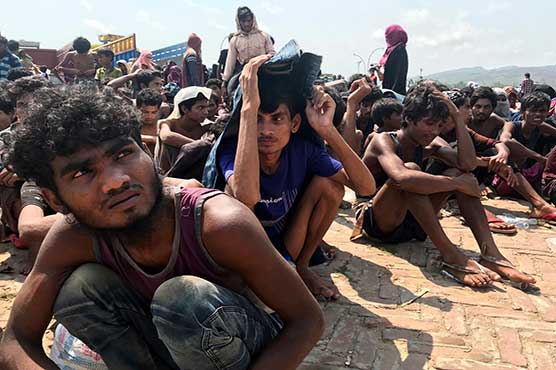Rohingya survivors tell of misery and death at sea; hundreds still adrift
Cox’s Bazar (Reuters) – Rohingya refugee Shahab Uddin thought the wooden trawler he boarded in February would be his ticket out of a camp in Bangladesh to a better life in Malaysia.
Instead, the voyage nearly killed him.
The 20-year-old was among almost 400 survivors pulled from the water, starving, emaciated and traumatized after the boat failed to reach Malaysia and spent weeks adrift before returning to Bangladesh in mid-April.
Hundreds more refugees are stranded on at least two other trawlers, rights groups say, as Southeast Asian governments tighten borders to keep out the new coronavirus, threatening a repeat of a 2015 boat crisis when hundreds of people died.
The United Nations has implored authorities to let the boats land, but anti-refugee sentiment is surging in Malaysia and governments say borders are sealed to keep out the coronavirus.
In interviews with Reuters, seven survivors from the rescued boat recalled two harrowing months.
Estimates of the number of people who died on the boat ranged from several dozen to more than 100 – nobody kept count – but their accounts were consistent.
The survivors described hundreds of men, women, and children crammed on the boat, unable to move, squatting in rain and scorching sun until, as food and water ran out, they began to die of starvation, thirst, and beatings, their bodies tossed overboard. Some wept as they spoke.
“I thought I would not come back home alive,” said Uddin. “I missed my family, especially my parents.”
The group Fortify Rights said in a statement last week the operators of the boat “held their victims in conditions similar to slavery for the purposes of exploitation”.
Reuters was unable to identify or contact the crew for comment.
Amnesty International urged governments to protect stranded Rohingya and allow them to land. It estimated 800 more people were at sea. Several dozen people from one boat landed on the south coast of Bangladesh on Saturday.
Malaysia defends its policy of turning boats away. Authorities have acted lawfully to defend the country’s sovereignty and are ready to do so again, its minister for internal affairs said in a statement on Thursday.
More than a million Rohingya, members of a Muslim minority from Myanmar, live in camps in southern Bangladesh after fleeing from largely Buddhist Myanmar’s Rakhine State.
Most fled an army crackdown in 2017 that the United Nations says was carried out with genocidal intent. Myanmar denies genocide and says it was responding to insurgent attacks.
‘Better Off In Malaysia’
Although the Rohingya people trace their ancestry in Rakhine back centuries, Myanmar says they are illegal immigrants from South Asia.
For years, Rohingya from Myanmar and Bangladesh have fled by boat for Thailand and Malaysia when the seas are calm between October and April. Hundreds died in 2015 after a crackdown in Thailand led smugglers to abandon their human cargo at sea.
In Bangladesh, Uddin made a little money driving motorized tuk-tuks but said refugees were becoming more confined.
The government restricts internet and cell phone access and has begun putting up barbed-wire fences around the camps, citing security. Uddin said it began to feel like prison.
“I thought going to Malaysia by whatever way would at least save me. Many have made it to Malaysia and are better off.”
He said he and several friends met a man in a shanty town who took them by boat to a trawler where hundreds of people were already crowded on board – men on the lower deck, women on the top. Many of the young women were due to be married in Malaysia.
Another refugee, Enamul Hasan, also 20, said an uncle in Malaysia urged him to go there. “I wanted to go to Malaysia to end my family’s poverty,” he said.
Six of the seven survivors Reuters interviewed said they had gone willingly. The seventh, aged 16, said he was taken by unknown men against his will.
The misery began as soon as they set out.
“We ate almost nothing,” said Uddin. “Little kids would cry for water.”
Weeping And Praying
After a week the boat arrived off Malaysia, where it waited for several days before the crew said they could not disembark and would have to return to Bangladesh.
They crossed back over the Bay of Bengal.
“We faced storms three times,” said Uddin.
He said he was made to serve as an enforcer for the crew and beat anyone who stepped out of line. “If I didn’t want to beat them, I myself would be beaten,” he said.
Meanwhile, some desperate passengers began to drink sea water.
“By the wonderful grace of God, the water would seem sweet,” said Hasan.
“Many jumped into the water … everyone was saying that it was much better to die in the water than dying in the ship.”
At night, the passengers held one another, weeping and praying.
Eventually the boat stopped again, off Myanmar, survivors said, but again it could not dock.
“People kept dying and would be thrown overboard,” said Hasan. “I began to wonder when I would die.”
The refugees eventually forced the captain to take them back to Bangladesh where, one night, they made landfall.
A coastguard official there at the time said they were a shocking sight: “Many of them were stick-thin, some unable to stand.”
Muriel Boursier, head of mission for Doctors Without Borders in Bangladesh, who met survivors later, said many could not walk. Some grieved for lost relatives, staring blankly.
Some survivors were taken to hospital but most went to a quarantine camp, unaware of the coronavirus that had taken hold during their voyage.
“It’s difficult to understand that no state is able to open its doors,” Boursier said.
Uddin said his parents hardly recognised him but he was thankful to be back, though he had little hope for his future.
“It’s better to die here than to die at sea,” he said.


